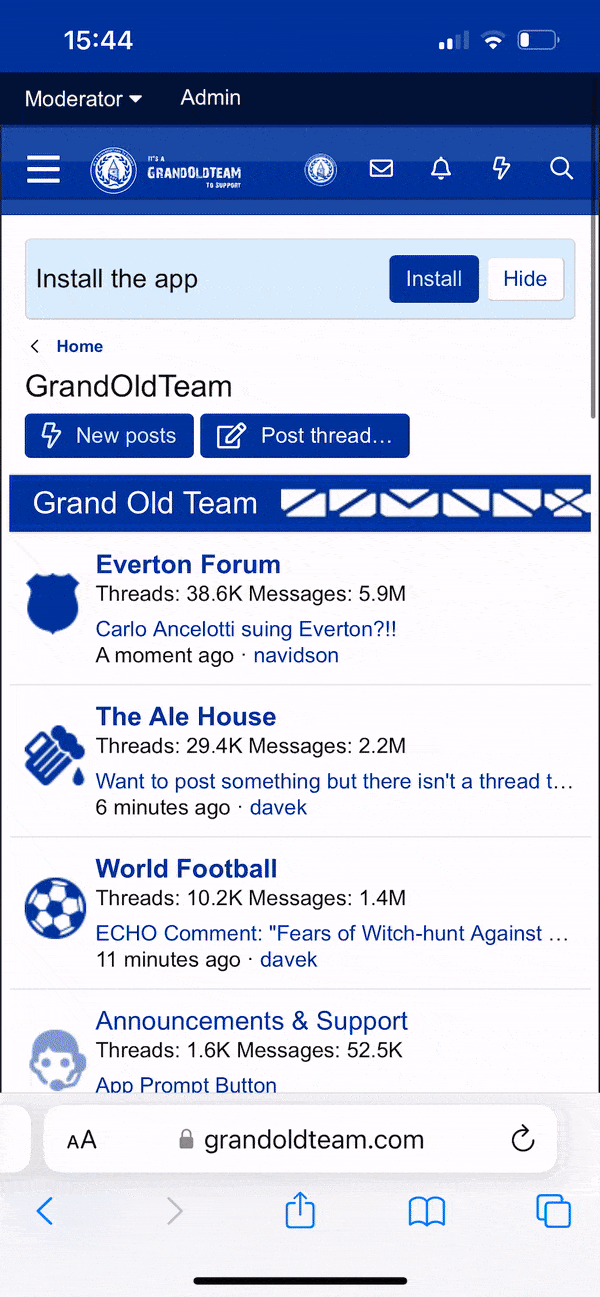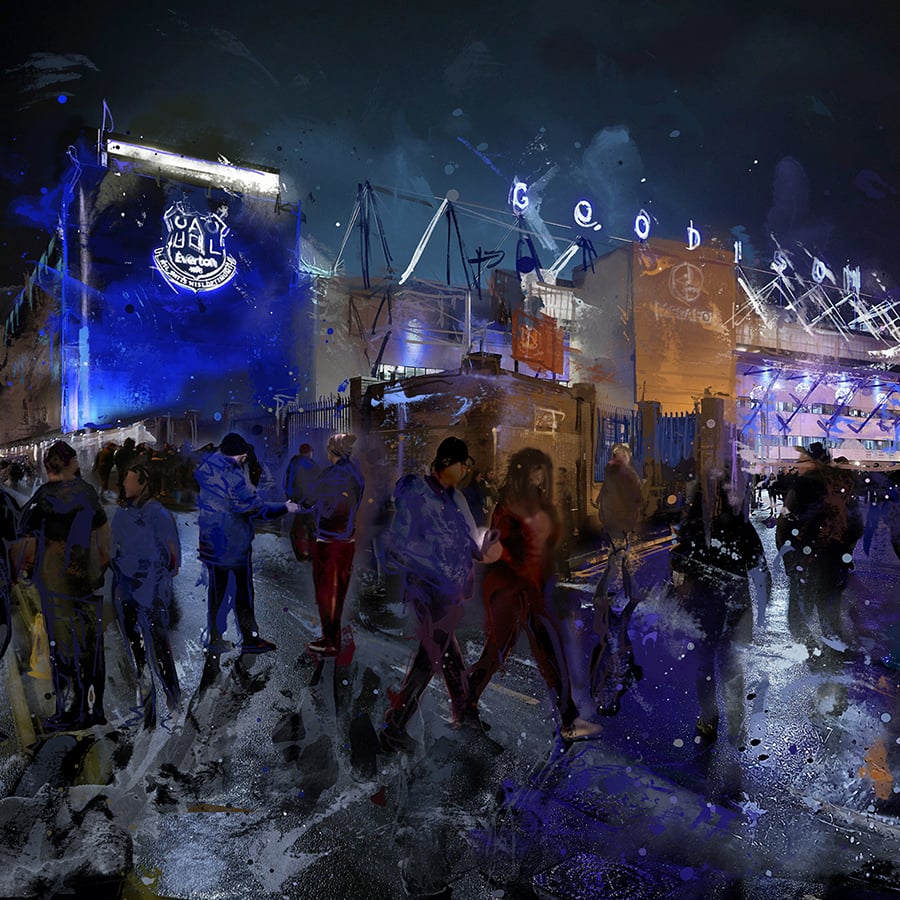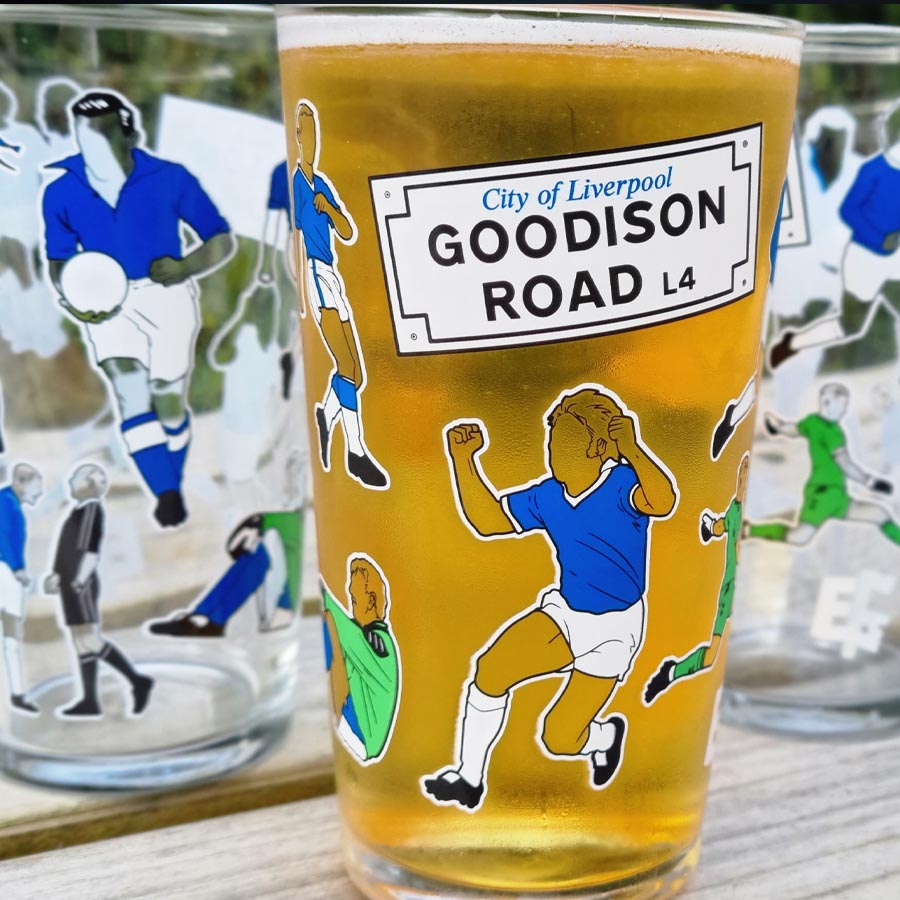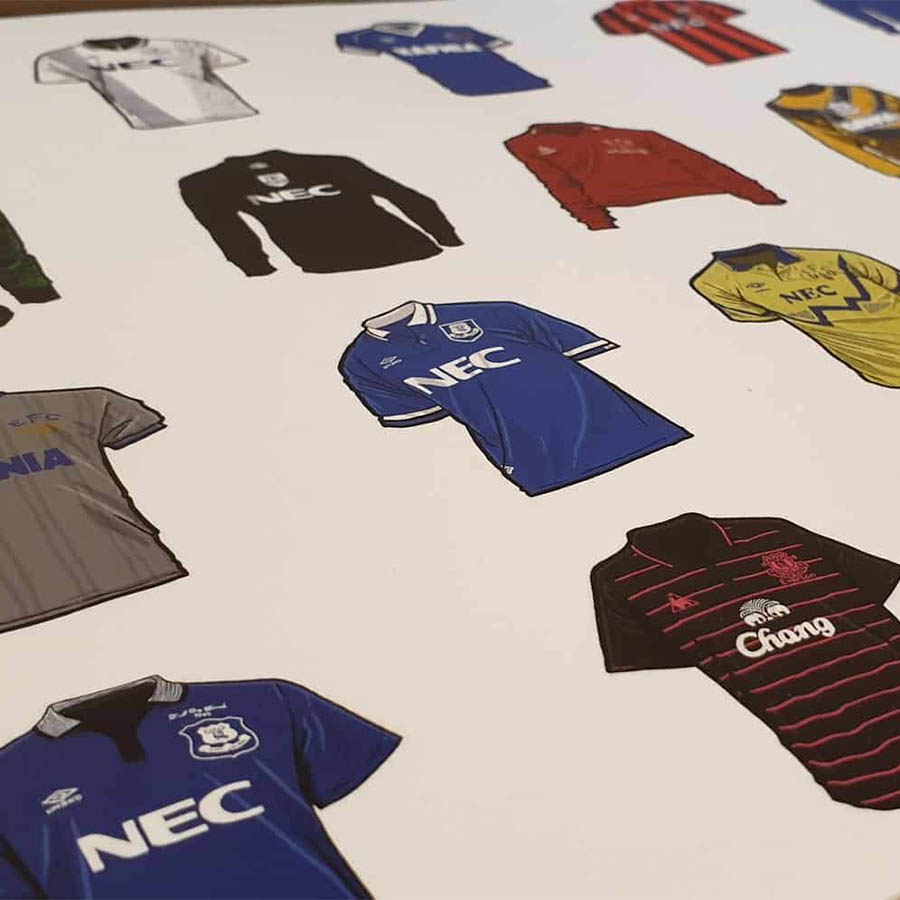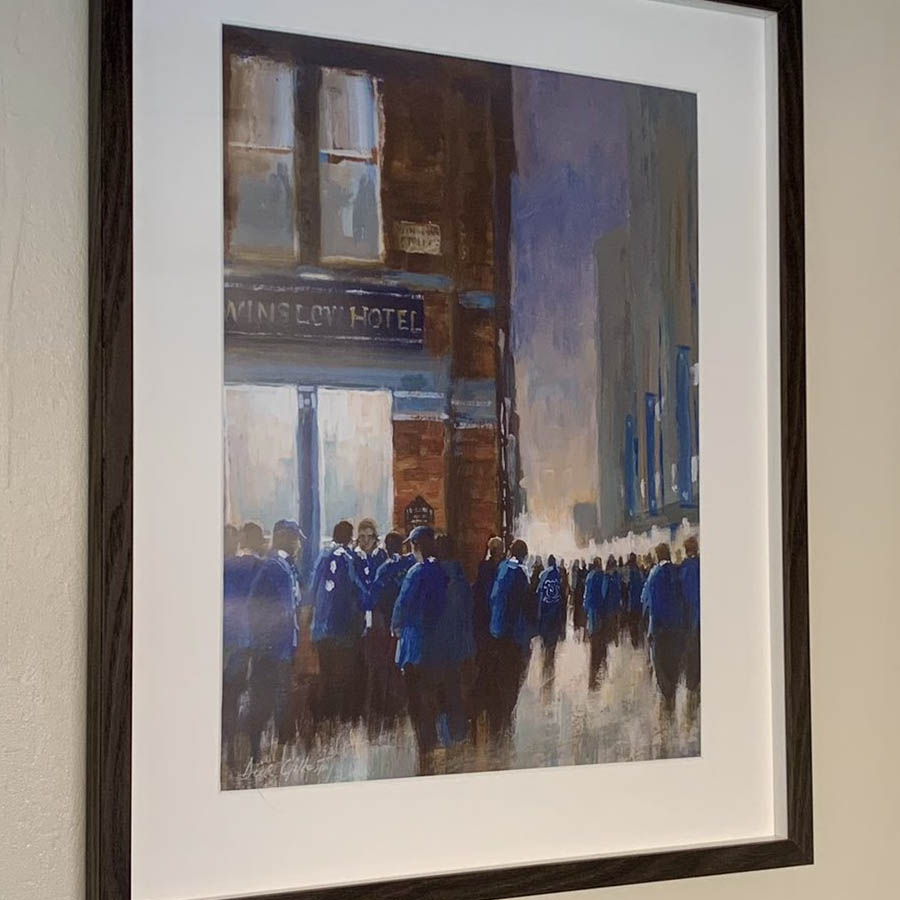TheAlmightyFloater
Player Valuation: £30m
Just an article floating about twitter. Thought maybe some people would want to read it.
http://soccergods.com/2015/01/28/everton-history-success/
To begin, an apology to Everton fans. Compared to not so much sleeping as comatose giants such as Sheffield Wednesday, Nottingham Forest and Leeds, their club is in robust health. The Everton of recent years is a thriving Premier League outfit, with the Toffees holding their own against bigger and richer rivals through a pleasing mix of smart, if unfashionable recruitment from smaller clubs and Scotland (Leighton Baines, Phil Jagielka and Steven Naismith), burgeoning young talent (John Stones and Ross Barkley), Mr. Dependables (criminally unheralded one-club stalwart Leon Osman), and the odd big splash in the transfer market (Romelu Lukaku). It’s all carefully mentored by the undoubtedly elegantly manicured hands of bright young manager Roberto Martínez.
Yet in the modern era, Everton represents something of a throwback, albeit an admirable one. Money is tight (and has been forever, it seems), the owner Bill Kenwright is a local boy made good, and the ground – wonderful, evocative old Goodison Park, from St Luke’s Church tucked in the corner to the rowdy Gwladys Street end – still recalls those three cornerstones of the traditional English matchday experience: the smell of tobacco; endless, roiling noise; and a notable lack of comfort.
Upward progress, when it comes, takes the form of small steps – a decent but reasonably priced signing here, a good young player emerging there, rather than the giant leaps taken at places like Manchester City after the Sheikh Mansour revolution, or Manchester United this summer just gone. Compared to the Walmarts of Stamford Bridge and the Etihad, Everton today is a corner shop – cherished, essential, but financially outmatched.
It was not always thus. Everton has had not just one but a number of golden eras – most notably in the 1920s, when the side was led by the great Dixie Dean, the team’s all-time leading goalscorer who once scored 60 goals in a season, and the 1960s, when names like Young, Kendall, Harvey, Ball and Royle led Everton to two league titles, two FA Cup final appearances, and five consecutive European qualifications – the last achievement a record for the time.
But while Everton supporters cherish these sepia-toned moments, it is a more recent period that stirs the memories of fans old enough to remember the days when watching soccer meant rather thinner gruel than the gluttony of today’s Super Sunday double and triple TV bills.
Things were looking grim for Everton in 1981. The 1970s had come and gone without disturbing the dust in the Goodison Park trophy cabinet, and the success of the 1960s was fading. Worse, over the road at Anfield, rival Liverpool was in the midst of its own golden years, which would see the club win an astonishing 11 league titles and four European Cups between 1973 and 1990.
Then Howard Kendall, considered by many to be one of the greatest English players never to represent his country, took over as Everton manager. He got off to a slow start – during a stultifying 0-0 draw with Coventry on New Year’s Eve in 1983, with under 14,000 shivering on the Goodison terraces, the first chants of “Kendall Out” were heard. A few weeks later, with Everton heading for defeat in a League Cup tie at third division Oxford, home midfielder Kevin Brock accidentally played in pint-sized striker Adrian Heath for a late equalizer – and probably saved Kendall’s job.
It was a fortuitous moment. Everton made it to the final of the competition, losing narrowly to Liverpool in a replay at Manchester City’s Maine Road, and more importantly, reached the final of the FA Cup, beating Watford at Wembley and ending a 14-year wait for a trophy. Everton’s latest glory years had begun.
Under Kendall, Everton would win the league and the European Cup Winners Cup in 1985 and the league again in 1987. The club also reached FA Cup finals in 1985 and 1986 (losing to Manchester United and Liverpool, respectively), and finished runners-up in the league in 1986 (behind Liverpool, who won the league and cup double that year).
The players that carried Everton to such success were a compelling mix of brawn, (footballing) beauty and brains. There was bearish goalkeeper Neville Southall, once a trash man in his native north Wales, who would play a record 578 league games for the club. Ahead of him was another Welshman, elegant central defender Kevin Ratcliffe. One of the club’s most important players was England midfielder Peter Reid, a snarling, snapping bundle of energy who drove the team forward relentlessly and would go on to play for and manage Manchester City. Skill and smarts were provided by Irish wide midfielder Kevin Sheedy, who had, to use that most 1980s of soccer tributes, “a left foot that could shell peas,” and on the other side, the energetic Trevor Steven, another England international. Up front there was powerful, abrasive Scottish striker Graeme Sharp (scorer of a breathtaking goal against Liverpool in 1985), alongside powerful, abrasive Scottish striker Andy Gray. When Gray left, he was replaced by Gary Lineker, who scored 30 goals in the 1985-86 season before moving to Barcelona.
One of the finest examples of this Everton team in its pomp came in April 1985, when the Toffees took on Sunderland at Goodison on their way to the league title (Kendall’s side would eventually finish 13 points clear of Liverpool). After the visitors took the lead, Everton simply steamrollered the opposition – Reid driving in a low cross for Gray to power in a diving header for the equalizer, Steven crossing for another spectacular Gray header to put the home team in front as the bodies surged forward on the Gwladys Street terrace, then Steven scampering down the right and blasting home from a tight angle. Everton’s fourth, an own goal, came almost as an afterthought – with play this muscular, this powerful, Everton could have scored twenty.
Another vintage display came in February 1986, after Lineker’s arrival brought a rapier cut and thrust to Everton’s forward play. Manchester City was swept aside 4-0 that chilly night, with the England striker scoring a hat trick. A sequence towards the end of the game, with Everton battering chance after chance at hapless City goalkeeper Eric Nixon, captures the relentless, pulverizing nature of the team’s style.
Then there were the nights like the one when Bayern Munich were beaten 2-0 at Goodison in the European Cup Winners Cup semi-final in 1985, when it felt like there was hardly a team in Europe that could have lived with Everton.
Sadly, we would never know. On May 29, 1985, prior to the European Cup final between Juventus and Liverpool, rioting fans caused the death of 39 Juventus supporters at Heysel Stadium. Soon after, UEFA banned English clubs from competing in Europe. After leading Everton to another league title in 1987, Kendall moved to Athletic Bilbao, claiming he was frustrated by a lack of European football.
“Leaving Everton broke my heart,” said Kendall in a 2013 interview. “At that time it was a real problem for the club with the ban. I know it was a terrible human tragedy that caused it, but it also had a serious effect on the club… the fans believed we were the best in Europe, the players went out believing they would never be beaten and who knows whether we were going to be the best in Europe? We were denied the opportunity to find out.”
Kendall spent two years in Bilbao before returning to manage Manchester City, where he made the Maine Road club competitive for the first time in an age. In 1990, however, he walked out on City to return to Goodison Park, saying that City had been “an affair” but that Everton was a marriage. But the glory days could not be recaptured, and Kendall was unable to lift the club above mid-table.
Since then, life at Everton has maintained an easygoing kind of charm, with neither the ups nor the downs being particularly dramatic. The club briefly threatened a return to past glories during the Joe Royle “Dogs of War” era, winning the FA Cup for the fifth time in 1995 and finishing sixth in the league in 1996. Everton regularly challenged for European qualification under David Moyes, coming fourth in the 2004-05 season, and may yet compete for honors under Martínez, whose unruffled, cerebral style fits well with Kenwright’s patient stewardship and the club’s old nickname of the “School of Science.”
It’s been a rough second season for Martínez, whose side is currently far adrift of European possibilities. Fortunately for the manager, Everton fans, like their owner, are mostly a patient bunch. Perhaps that comes from a pride in the club’s history and its sense of community; or, perhaps it comes from a stoicism innate to the city of Liverpool, where life has not always been easy, especially during Everton’s glory years under Kendall. The 1980s was a period of major social unrest in Liverpool, with mass unemployment, the Toxteth riots, and the city ground down by the brutalities of Margaret Thatcher’s government and the vagaries of a militant left-wing city council. Yet as the city suffered, so its soccer teams flourished, becoming a source of local pride in a difficult time.
Such patience is a rare quality in the modern era, where heightened exposure to the greats of the global game has made fans of many clubs behave with an unseemly lack of grace in their desperation to see their team join the Champions League party. Nor can it be easy for Everton fans to watch massive outside investment allow teams such as Chelsea and Manchester City, both of whom possess considerably inferior trophy winning pedigrees, jump the queue in the search for glory – although, given that Everton was one of the so-called “Big Five” English clubs that encouraged the Premier League breakaway back in the late 1980s and early 1990s, perhaps Toffees fans should not complain too much.
Kenwright, meanwhile, has tried to attract similar investment on a number of occasions in the past. Until he does, Everton supporters would be well advised to enjoy the unique atmosphere at their club and its lovely old ground. If their team seems a long way from winning trophies, equally it is far from the undignified clamor of those who have elected to pursue those glories at all costs. And that, in today’s game, is surely something to be cherished.
http://soccergods.com/2015/01/28/everton-history-success/
To begin, an apology to Everton fans. Compared to not so much sleeping as comatose giants such as Sheffield Wednesday, Nottingham Forest and Leeds, their club is in robust health. The Everton of recent years is a thriving Premier League outfit, with the Toffees holding their own against bigger and richer rivals through a pleasing mix of smart, if unfashionable recruitment from smaller clubs and Scotland (Leighton Baines, Phil Jagielka and Steven Naismith), burgeoning young talent (John Stones and Ross Barkley), Mr. Dependables (criminally unheralded one-club stalwart Leon Osman), and the odd big splash in the transfer market (Romelu Lukaku). It’s all carefully mentored by the undoubtedly elegantly manicured hands of bright young manager Roberto Martínez.
Yet in the modern era, Everton represents something of a throwback, albeit an admirable one. Money is tight (and has been forever, it seems), the owner Bill Kenwright is a local boy made good, and the ground – wonderful, evocative old Goodison Park, from St Luke’s Church tucked in the corner to the rowdy Gwladys Street end – still recalls those three cornerstones of the traditional English matchday experience: the smell of tobacco; endless, roiling noise; and a notable lack of comfort.
Upward progress, when it comes, takes the form of small steps – a decent but reasonably priced signing here, a good young player emerging there, rather than the giant leaps taken at places like Manchester City after the Sheikh Mansour revolution, or Manchester United this summer just gone. Compared to the Walmarts of Stamford Bridge and the Etihad, Everton today is a corner shop – cherished, essential, but financially outmatched.
It was not always thus. Everton has had not just one but a number of golden eras – most notably in the 1920s, when the side was led by the great Dixie Dean, the team’s all-time leading goalscorer who once scored 60 goals in a season, and the 1960s, when names like Young, Kendall, Harvey, Ball and Royle led Everton to two league titles, two FA Cup final appearances, and five consecutive European qualifications – the last achievement a record for the time.
But while Everton supporters cherish these sepia-toned moments, it is a more recent period that stirs the memories of fans old enough to remember the days when watching soccer meant rather thinner gruel than the gluttony of today’s Super Sunday double and triple TV bills.
Things were looking grim for Everton in 1981. The 1970s had come and gone without disturbing the dust in the Goodison Park trophy cabinet, and the success of the 1960s was fading. Worse, over the road at Anfield, rival Liverpool was in the midst of its own golden years, which would see the club win an astonishing 11 league titles and four European Cups between 1973 and 1990.
Then Howard Kendall, considered by many to be one of the greatest English players never to represent his country, took over as Everton manager. He got off to a slow start – during a stultifying 0-0 draw with Coventry on New Year’s Eve in 1983, with under 14,000 shivering on the Goodison terraces, the first chants of “Kendall Out” were heard. A few weeks later, with Everton heading for defeat in a League Cup tie at third division Oxford, home midfielder Kevin Brock accidentally played in pint-sized striker Adrian Heath for a late equalizer – and probably saved Kendall’s job.
It was a fortuitous moment. Everton made it to the final of the competition, losing narrowly to Liverpool in a replay at Manchester City’s Maine Road, and more importantly, reached the final of the FA Cup, beating Watford at Wembley and ending a 14-year wait for a trophy. Everton’s latest glory years had begun.
Under Kendall, Everton would win the league and the European Cup Winners Cup in 1985 and the league again in 1987. The club also reached FA Cup finals in 1985 and 1986 (losing to Manchester United and Liverpool, respectively), and finished runners-up in the league in 1986 (behind Liverpool, who won the league and cup double that year).
The players that carried Everton to such success were a compelling mix of brawn, (footballing) beauty and brains. There was bearish goalkeeper Neville Southall, once a trash man in his native north Wales, who would play a record 578 league games for the club. Ahead of him was another Welshman, elegant central defender Kevin Ratcliffe. One of the club’s most important players was England midfielder Peter Reid, a snarling, snapping bundle of energy who drove the team forward relentlessly and would go on to play for and manage Manchester City. Skill and smarts were provided by Irish wide midfielder Kevin Sheedy, who had, to use that most 1980s of soccer tributes, “a left foot that could shell peas,” and on the other side, the energetic Trevor Steven, another England international. Up front there was powerful, abrasive Scottish striker Graeme Sharp (scorer of a breathtaking goal against Liverpool in 1985), alongside powerful, abrasive Scottish striker Andy Gray. When Gray left, he was replaced by Gary Lineker, who scored 30 goals in the 1985-86 season before moving to Barcelona.
One of the finest examples of this Everton team in its pomp came in April 1985, when the Toffees took on Sunderland at Goodison on their way to the league title (Kendall’s side would eventually finish 13 points clear of Liverpool). After the visitors took the lead, Everton simply steamrollered the opposition – Reid driving in a low cross for Gray to power in a diving header for the equalizer, Steven crossing for another spectacular Gray header to put the home team in front as the bodies surged forward on the Gwladys Street terrace, then Steven scampering down the right and blasting home from a tight angle. Everton’s fourth, an own goal, came almost as an afterthought – with play this muscular, this powerful, Everton could have scored twenty.
Another vintage display came in February 1986, after Lineker’s arrival brought a rapier cut and thrust to Everton’s forward play. Manchester City was swept aside 4-0 that chilly night, with the England striker scoring a hat trick. A sequence towards the end of the game, with Everton battering chance after chance at hapless City goalkeeper Eric Nixon, captures the relentless, pulverizing nature of the team’s style.
Then there were the nights like the one when Bayern Munich were beaten 2-0 at Goodison in the European Cup Winners Cup semi-final in 1985, when it felt like there was hardly a team in Europe that could have lived with Everton.
Sadly, we would never know. On May 29, 1985, prior to the European Cup final between Juventus and Liverpool, rioting fans caused the death of 39 Juventus supporters at Heysel Stadium. Soon after, UEFA banned English clubs from competing in Europe. After leading Everton to another league title in 1987, Kendall moved to Athletic Bilbao, claiming he was frustrated by a lack of European football.
“Leaving Everton broke my heart,” said Kendall in a 2013 interview. “At that time it was a real problem for the club with the ban. I know it was a terrible human tragedy that caused it, but it also had a serious effect on the club… the fans believed we were the best in Europe, the players went out believing they would never be beaten and who knows whether we were going to be the best in Europe? We were denied the opportunity to find out.”
Kendall spent two years in Bilbao before returning to manage Manchester City, where he made the Maine Road club competitive for the first time in an age. In 1990, however, he walked out on City to return to Goodison Park, saying that City had been “an affair” but that Everton was a marriage. But the glory days could not be recaptured, and Kendall was unable to lift the club above mid-table.
Since then, life at Everton has maintained an easygoing kind of charm, with neither the ups nor the downs being particularly dramatic. The club briefly threatened a return to past glories during the Joe Royle “Dogs of War” era, winning the FA Cup for the fifth time in 1995 and finishing sixth in the league in 1996. Everton regularly challenged for European qualification under David Moyes, coming fourth in the 2004-05 season, and may yet compete for honors under Martínez, whose unruffled, cerebral style fits well with Kenwright’s patient stewardship and the club’s old nickname of the “School of Science.”
It’s been a rough second season for Martínez, whose side is currently far adrift of European possibilities. Fortunately for the manager, Everton fans, like their owner, are mostly a patient bunch. Perhaps that comes from a pride in the club’s history and its sense of community; or, perhaps it comes from a stoicism innate to the city of Liverpool, where life has not always been easy, especially during Everton’s glory years under Kendall. The 1980s was a period of major social unrest in Liverpool, with mass unemployment, the Toxteth riots, and the city ground down by the brutalities of Margaret Thatcher’s government and the vagaries of a militant left-wing city council. Yet as the city suffered, so its soccer teams flourished, becoming a source of local pride in a difficult time.
Such patience is a rare quality in the modern era, where heightened exposure to the greats of the global game has made fans of many clubs behave with an unseemly lack of grace in their desperation to see their team join the Champions League party. Nor can it be easy for Everton fans to watch massive outside investment allow teams such as Chelsea and Manchester City, both of whom possess considerably inferior trophy winning pedigrees, jump the queue in the search for glory – although, given that Everton was one of the so-called “Big Five” English clubs that encouraged the Premier League breakaway back in the late 1980s and early 1990s, perhaps Toffees fans should not complain too much.
Kenwright, meanwhile, has tried to attract similar investment on a number of occasions in the past. Until he does, Everton supporters would be well advised to enjoy the unique atmosphere at their club and its lovely old ground. If their team seems a long way from winning trophies, equally it is far from the undignified clamor of those who have elected to pursue those glories at all costs. And that, in today’s game, is surely something to be cherished.

